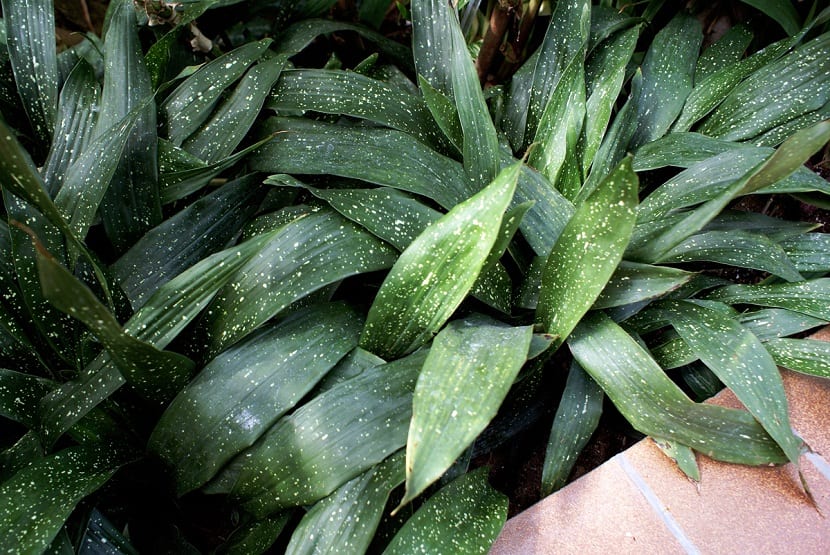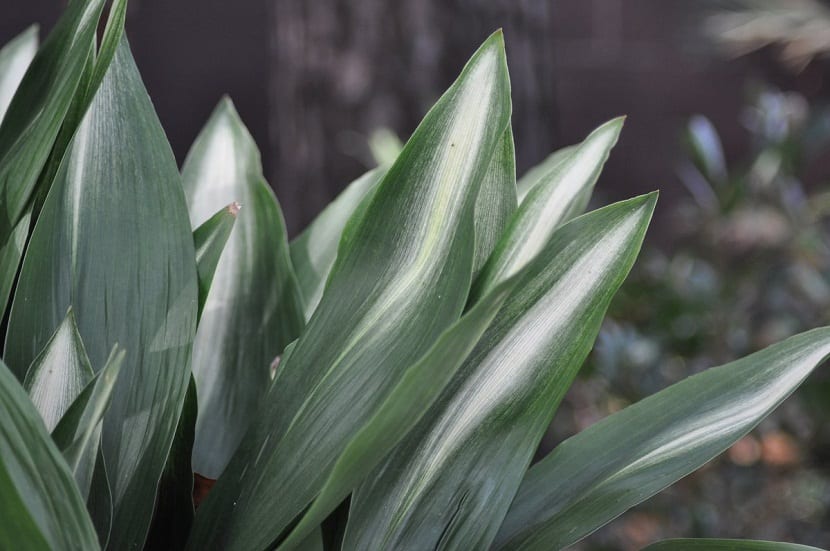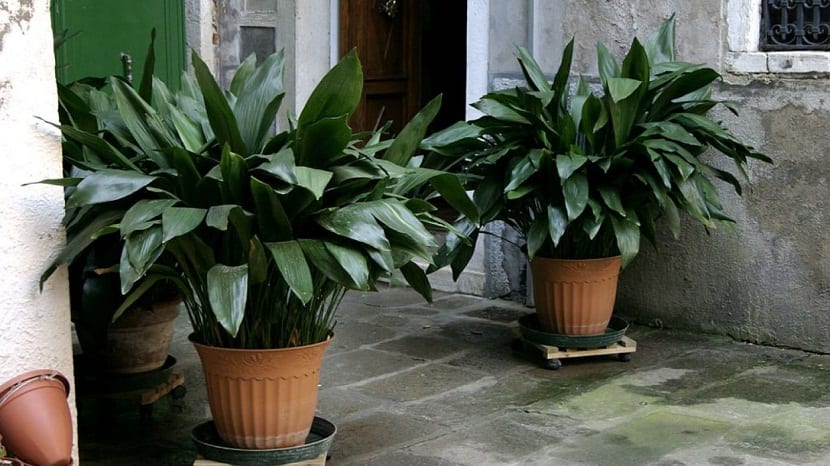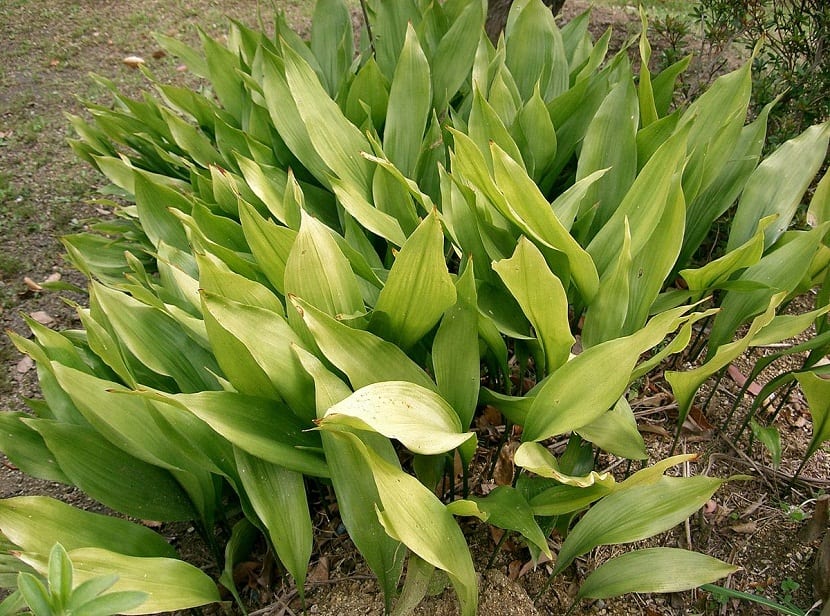
The Aspidistra is a plant that is used in interior decoration, since it has the particularity that it can grow in places with very little light. Unlike other plants, this one has the ability to survive both low humidity and low light.
It is a plant native to China, where it occurs in the freshness of very dense jungles. This genus comes from the family of the Ruscaceae.
Features

Apart from its main and most outstanding characteristic that allows it to stay alive where other plants cannot, this is a plant that requires minimal care. However, due to its decorative function, it is advisable to pay attention to it, since this way you will be able to have a beautiful plant for many years.
It is capable of generating in its natural habitat beautiful deep red flowers, which are formed at ground level. The fruit that the plant produces is a dark, almost black berry that contains multiple seeds inside.
It is a indoor plant very interesting for its leaves, formed by a single rhizome, its leaves can reach 70 cm. long. These are supported by very long green petioles, whose shape is lanceolate or oval, being also green and some non-uniform mottled.
Aspidistra species
Aspidistra Elatior- Variegata
Its main characteristic is found in the leaves, since they are variegated from cream and whiteThis characteristic prevails as long as no excess nutrients are supplied through compost.
Aspidistra Elatior-Lurida
This species is characterized by the long petioles that emerge from the ground and which are responsible for bearing the long leaves of up to 70 centimeters. It is a rhizome and is usually cultivated for its ornamental foliage.
Farming
It tolerates temperatures around -4º C quite well, so we can say that it is a plant resistant to cold and heat. However and when we have it in our house, it is important to take care of it from temperatures that are around 5ºC for long periods of time, likewise, in the winter season it is preferable keep it away from heating.
It is recommended to place them in spaces where they receive some light and the temperature is not excessively high or low, for example, the porch of the house would be perfect. Remember that the more care we offer you, the longer you will stay with usIt will even give you new leaves throughout the year.
That is why it must be placed in places where it does not get direct sunlight, even though it can grow in a very limited way with little or no light. Keep their sheets clean, without the need to use special cleaners, since it will be enough to periodically wipe them with a very soft damp cloth. Also avoid exposing it to smoke or very strong and continuous currents of air.
Regarding the amount of humidity necessary, this will depend on the season of the year, since if you are in the period from autumn to winter the plant will not need too much watering, only every time the substrate has dried, on the contrary, between spring and summer the waterings must be abundant and continuous.
When to do the transplant?

It is recommended to do the transplant every two or three years, the time stipulated so that the roots of the Aspidistra have already reached all the available space. It is important that you have an appropriate substrate, so it should contain beech leaves, sand and peat.

When to fertilize and with what type of fertilizer?
This point is very important in the care and cultivation of the plant. The ideal season to make fertilizers on a monthly basis is during spring and summer, and under no circumstances in autumn or winter. Regarding the type of fertilizer, you must pay close attention to the fertilizer that you acquire, since for your plant to develop correctly it requires certain components, mainly, a high nitrogen content together with macro elements such as potassium and phosphorus, in addition to micro elements such as iron, manganese, magnesium, zinc, copper, molybdenum and boron.
Try not to use the amount indicated on the product label, rather use a smaller amount along with a good substrate, which will be of great benefit to our plant as long as the transplant is done in the way we have indicated before.
Flowering takes place during the summer, taking place without problems in the natural habitat of the plant but, its dark red flowers rarely occur when they are inside a house. It does not require pruning, since they only need you to remove the already withered leaves. This is important to prevent the appearance of diseases caused by parasites.
How does it reproduce?
The multiplication of the plant takes place through the division of the rhizomes, which is done manually. The time to do it is when the transplant is doneFor this you must cut each rhizome with a previously disinfected and very sharp knife.
Pay attention and check that each one has at least three leaves and that the roots are fully developed. Later, you must apply a sulfur-based fungicide in the area where you have made the cuts. Prepare a pot for each rhizome with the same substrate as the mother plant. In principle, you should provide them with a very cool environment, with shade, this will encourage new leaves to originate, which is an unequivocal sign that the roots have taken root correctly.
Plagues and diseases
Like any other, there are several diseases and pests that can affect this plant. We will detail them below so that you can identify and treat them in time. Brown spots located on the back of the leaves, these being a sure sign that the plant has been invaded by the mealybug. These are easily detected with a magnifying glass through which you can see a kind of dark colored shield.

To remove them it will be enough to pass a cotton swab moistened with alcohol on the affected part or spray the leaves with water and neutral soap, once this is done, sponge very delicately, and then rinse very well with water, eliminating all residue. In case they are several plants and very large, you can also opt for antiparasitics.
Leaves with burns, this being one of the reasons why these leaves are seen with burns is that the plant has been exposed to direct sunlight or high temperatures. The solution is to move the pot to a cooler place and with lighting not direct from the sun. When it is over-fertilized, the leaves will also appear burned and deteriorated, in that case you should suspend the fertilizer for at least two months. White and very tiny animals on the floor like aphids, an unmistakable parasite that can be easily eradicated with specific chemicals for this purpose.
Leaves with brown or yellow spots. When you notice something like this, check the leaves carefully for traces of cobwebs on the back of the leaf, which is a sign that it is being attacked by a very aggressive mite, the spider mite. What's more, you will observe how the leaves are collected in the form of a basket and end up falling.
To eradicate it, you can choose to moisten the plant more frequentlyIf the level of infestation is very serious, use chemicals. If, on the other hand, the plant is not very large, you can remove them manually by means of a cotton ball moistened with soap and later, remove the excess with water.